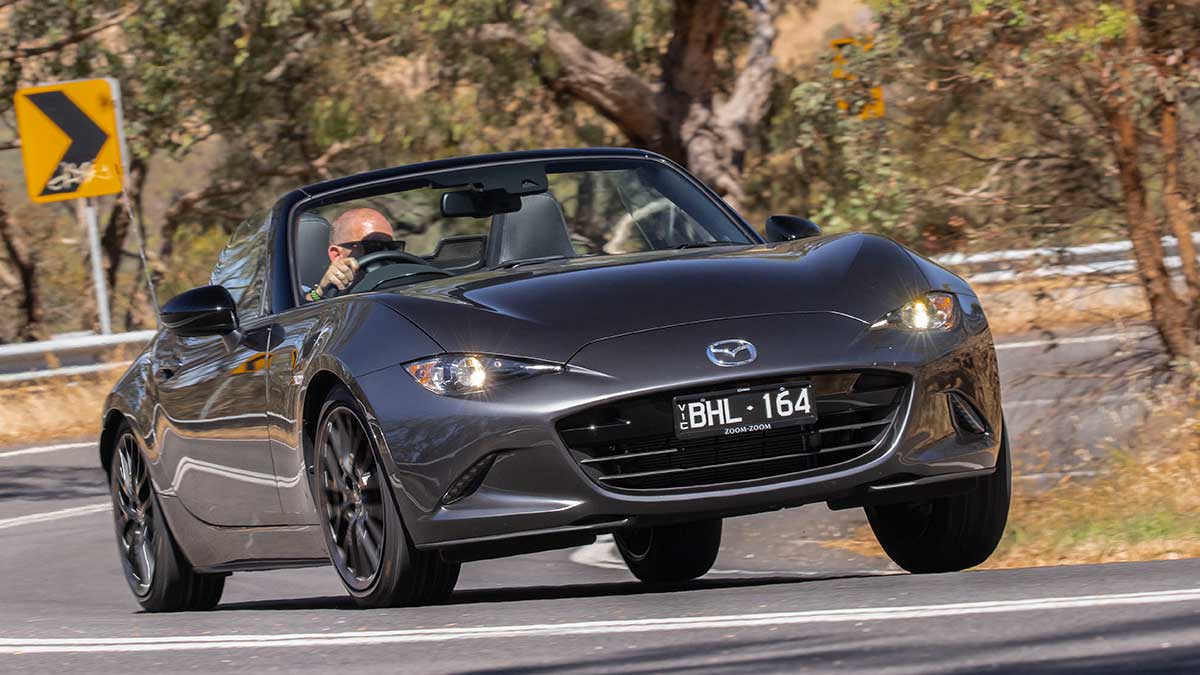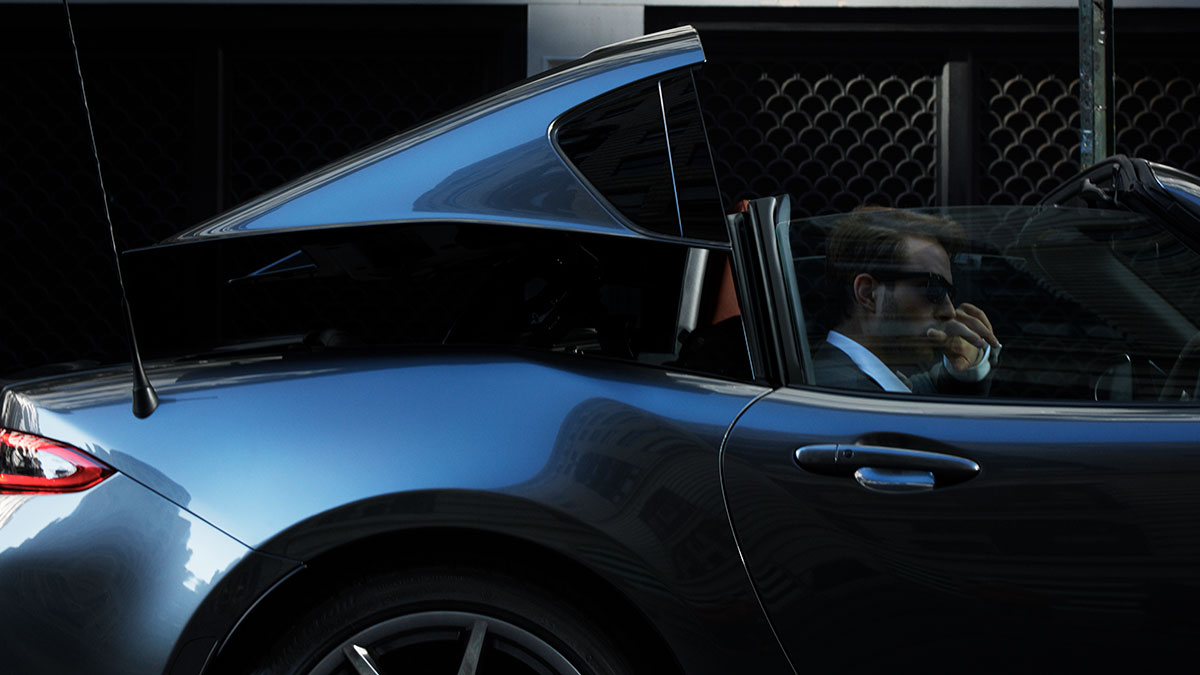The Foton Tunland joins Australia's dual-cab ute market as an affordable mild-hybrid diesel under $50,000, offering strong capability against tough competition.
Top of the topless: 2022 Mazda MX-5 road test review

Mazda's sporty convertible is as roomy as a straight jacket, but highlights the fact that size doesn't always matter.
Mazda has fed motoring enthusiasts a “lite diet” of entertainment since the MX-5 first launched three decades ago. The formula was simple: light weight, light-on-its-feet balance, and light into the cabin courtesy of the convertible design.
The latest iteration of the world’s most popular two-door convertible (well over one million have been sold) has seen very minor tweaks to the basic premise.
The headline changes are the deletion of the 1.5-litre engine and the inclusion of a stability-control operated vectoring system that lightly brakes the rear wheel to improve cornering turn in.
On this page
- How much does the Mazda MX-5 cost?
- Is the Mazda MX-5 safe?
- What's the Mazda MX-5 like inside?
- What's under the Mazda MX-5's bonnet?
- Is the Mazda MX-5 efficient?
- How does the Mazda MX-5 drive?
- Should I buy one?
How much does the Mazda MX-5 cost?
There are three tiers to the MX-5 range, all of which can be had with a manually operated soft-top or power-folding hard roof.
The party kicks off with the soft-top Roadster’s sticker price of $37,990 before on-road costs. That’s $42,444 driveaway for anyone living in Melbourne.
The GT ups the ante to $49,353 on the street, while the track-oriented GT RS is $52,479 tucked in your garage.
Despite the price premium, Mazda says the GT RS will account for most sales. Put that down to the easily spotted Brembo brakes that provide instant differentiation from the lower grades. The GT RS also has Bilstein shocks and a front strut brace. Good for handling; not as obvious on the bragging rights front.
Hard-top buyers can expect to pay around $4,100 more than the soft-top equivalent and ditching the six-speed manual gearbox for a six-speed automatic will add about $2,000 (not available on the GT RS).
Prospective owners have a choice of four standard paint colours: white, black, blue and “platinum quartz metallic”. The premium “soul red”, “machine grey” and “polymetal grey” shades add $595.
Service intervals are every 12 months or 10,000km and amount to $1817 over the first five trips.
The Mini convertible is the obvious rival, despite the price difference. An entry Mini with a 100kW/220Nm three-cylinder turbo engine costs $50,409 on the road but to match the Mazda’s performance you’ll need to spend $59,206 on a Mini Cooper S with a 141kW/280Nm 2.0-litre turbo engine.
Subaru’s BRZ matches the Mazda on price with a starting figure of $44,049 driveaway and it is a more accomplished drive… but you can’t drop the roof on a sunny day.
Is the Mazda MX-5 safe?
A 2015 crash-test rating for the Mazda MX-5 doesn’t reflect the focus on safety software required to earn a five-star rating in 2022.
The Mazda’s structural integrity was rated highly, though the driver’s head did touch the windscreen pillar and the steering wheel in the frontal crash test. It’s the price you pay for operating in such a confined environment.
Conversely, the absence of autonomous emergency braking and a lane-keep assist function didn’t hurt its overall score back in 2015.
That’s one of the reasons ANCAP has imposed a seven-year timestamp on its scores. If a car is still on sale after that date, it will be deemed “unrated” rather than be allowed to continue to inherit the original result.
So, Mazda has until the end of this year to re-test MX-5, which has now been fitted with enough safety software to theoretically earn high marks, though it doesn’t have a centre airbag to stop clashing heads.
The autonomous emergency braking works in forward and reverse, along with rear cross-traffic alert, lane-departure warning, traffic sign recognition and blind-spot monitoring.
What’s the Mazda MX-5 like inside?
Space is not in abundance in the MX-5. Some drivers may not even fit inside the diminutive cabin with the roof up and if they fold it out of the way, will find their vision obstructed by the top of the windscreen.
For those who can drop into the interior, it’s a stripped-back, driver-centric cockpit.
The seven-inch infotainment screen hails from a previous generation of Mazda interfaces, meaning it isn’t as fast to process requests or as crisp to view as something found in a Mazda CX-30. It is still recent enough to benefit from inbuilt satnav and Android Auto/Apple CarPlay connectivity.
Likewise, there’s no digital speedo in the otherwise well-presented and traditional “three dial” driver’s instrument panel. The analogue displays are easy to read day or night and there’s a digital trip-computer on the left side of the screen.
GT versions swap out the Roadster’s cloth seats for heated leather versions and upgrade the default six-speaker sound system to a nine-speaker Bose unit.
Storage space is limited. There are no door pockets or glovebox, instead a pair of cup-holder rings are mounted just behind the doors, along with a fold-down cubby storage that may or may not take a purse.
The boot is just as small at 130 litres (127 litres for hardtop versions). It will take a pair of overnight bags, so owners can enjoy a weekend away.
What’s under the Mazda MX-5’s bonnet?
A naturally aspirated (no turbo) 2.0-litre four-cylinder engine powers the MX-5 and it’s a gem. The outputs aren’t huge at 135kW and 205Nm, but they don’t need to be, given the little Mazda weighs in at around 1050kg with a manual gearbox, or 1080kg with the auto.
The redline is 7500 revs a minute and the MX-5 encourages you to go there. You need to hit 4000rpm to achieve peak torque and maximum power is another 3000rpm up the dial.
Is the Mazda MX-5 efficient?
Claimed combined fuel use is 6.8 litres over 100km, or 9.1 litres/100km around town with the manual gearbox.
Go with the automatic and the figures rise to 7.0 litres/100km in combined use and 9.7 litres/100km in urban operation.
In either case, Mazda recommends owners use 95 RON petrol.
How does the Mazda MX-5 drive?
The MX-5 epitomises the principle of making the most of what you’ve got. Power is far from prodigious but straight-line speed is not what the Mazda is built for (though it will hit 100km/h in the mid six-second mark).
The chassis balance and light mass makes this a grin-inducing corner carver, particularly on sinuous stretches of road. Steering feedback is as good as you’ll find this side of a premium European sports car and the weight and rate of turn are perfectly suited to the MX-5.
Toss in the feel-good factor of driving with the top down (not that we indulged in that experience given Melbourne’s recent weather) and this convertible stacks up as one of the most engaging cars on sale, where the driver inputs rather than engine outputs, largely determine the rate of progress.
MX-5 GT RS variants pick up a front strut brace and Bilstein shocks to enhance the cornering ability even more.
If you can’t stretch that far up the range, don’t stress. On the road the standard suspension is well tuned to deliver outstanding cornering ability and manual versions pick up a limited slip differential to maximise drive out of corners in low-grip conditions.
New for this year is the inclusion of “Kinematic Posture Control”.
The system lightly brakes the inside rear wheel during turn-in to a corner, which tightens the line without perceptibly reducing power, resulting in incremental gains in lap times around a circuit, or marginally faster manoeuvring on country roads.
When you’re not searching for a bendy bit of road, the MX-5 is also happy to play as a daily driver. The suspension isn’t hard enough to shake things up too much in city driving, the turning circle is laughably tight and the MX-5 fits into places you would consider parking most cars.
Owners will notice a bit of external noise filtering into the cabin, irrespective of whether they in a soft or hard-topped car. Insulation adds weight and that is an anathema for MX-5 engineers, so the fabric and plastic roofs are designed to keep the elements out, rather than being acoustic dampeners.
Should I buy one?
If you’re in the market for budget alfresco thrills, join the crowd. The MX-5 deserves its reputation as a sporty convertible that can double as a daily driver.
It also has a unique niche at this price point. There are quicker cars for similar money but they’re not convertibles and lack the enthusiasm of the Mazda’s rev-happy engine.
Then there are convertibles that cost 50 per cent more than the Mazda to deliver comparable performance.
That makes the Mazda the most viscerally elemental car in the segment … and it’s hard to argue with the price or polish.
The information provided is general advice only. Before making any decisions please consider your own circumstances and the Product Disclosure Statement and Target Market Determinations. For copies, visit racv.com.au. As distributor, RACV Insurance Services Pty Ltd AFS Licence No. 230039 receives commission for each policy sold or renewed. Product(s) issued by Insurance Manufacturers of Australia ABN 93 004 208 084 AFS Licence No. 227678.











